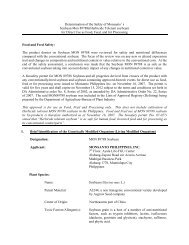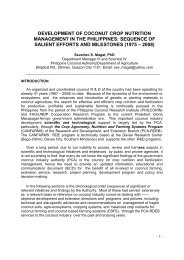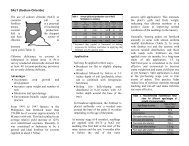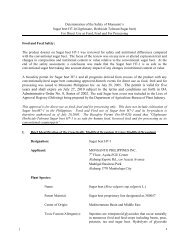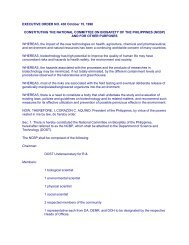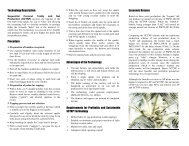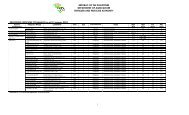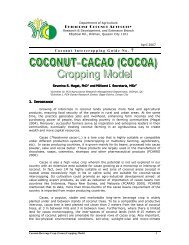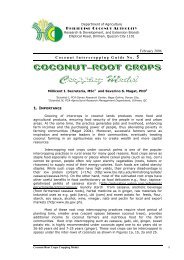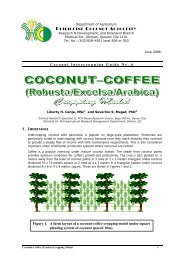2009 Annual Reports - Bureau of Fisheries and Aquatic Resources
2009 Annual Reports - Bureau of Fisheries and Aquatic Resources
2009 Annual Reports - Bureau of Fisheries and Aquatic Resources
Create successful ePaper yourself
Turn your PDF publications into a flip-book with our unique Google optimized e-Paper software.
ANNUAL REPORT <strong>2009</strong>Typhoon / disaster mitigation measuresSummary <strong>of</strong> Damages <strong>and</strong> Outline <strong>of</strong> Rehabilitation AssistanceAffectedDamage on aquacultureTyphoonfisherfolkArea (ha) Quantity (pcs) Value (Php)“Emong”“Ondoy”“Pepeng”Rehabilitation assistanceQuantity (pcs) Value (Php)10.98 260,950 847,530.00 549,000 274,500.00728 71.191,079,240 &40,940 kg2,787 1,079.75 7,910,981 &236,728 kg358,6756,304,190 179,338.0032,695,909 5,583,732 2,995,554Typhoon“Ondoy”“Pepeng”Damage on Equipment / Facilities Value (Php)3 payaos, 2 bancas, 1 MFC, plus infra 1,256,000.00at MBSH & NLFROS397 units various fishing gadgets& damages to government facilities2,180,000Rehabilitation assistance125,000.00 for fishing gears <strong>and</strong>3,750,000.00 for governmentfacilitiesRegion 02, being part <strong>of</strong> the typhoon belt,was again not spared from the wrath <strong>of</strong> tropicalcyclones. Three major typhoons visited the regionwith major damages incurred by the fisheries sector.As rehabilitation assistance, BFAR RO2 providespartial fingerling requirement to flooded fishponds<strong>and</strong> damaged cages <strong>and</strong> other production areas. Thebureau likewise provides fishing gear as assistanceto coastal folk who incur damages on their fishingequipment or gears.The following are measures recommendedby the BFAR RO2 Disaster Task Force to avoid or /<strong>and</strong> lessen impact <strong>of</strong> natural <strong>and</strong> other calamitiesto fishery projects:the fishpond at 4 meters interval wherein nets canbe attached immediately upon news <strong>of</strong> incomingtyphoon to prevent escape <strong>of</strong> stocks in case <strong>of</strong>flooding.6. or construct a covered hapa (net enclosure or cage)within the pond where stocks can be temporarilysecured in times <strong>of</strong> flooding. Use seine net to drivefishes towards the hapa.1. Consider timing <strong>of</strong> stocking <strong>of</strong> fingerlings such thatcritical periods can be avoided (floods <strong>and</strong> drought),abrupt change <strong>of</strong> salinity (for brackish water areas)<strong>and</strong> other water parameters due to floods <strong>and</strong> heavyrains.2. Increase <strong>and</strong> fortify pond dike for flood proneareas.3. Adhere to the Code <strong>of</strong> Practice for ResponsibleAquaculture FAO 214. Follow proper feeding rate <strong>and</strong>stock management to avoid fish kill. Proper zoningor spacing should be followed for fish cages to allowgood water flow <strong>and</strong> avoid pollution.4. Implement forced or emergency harvest duringoccurrence <strong>of</strong> drought, pollution or flood. Undersizedstock can be processed into tilanggit (daing) whilethe good sized can be marketed immediately orprocessed into a number <strong>of</strong> ways to increase value.5. Install sturdy poles around the inside perimeter <strong>of</strong>27



